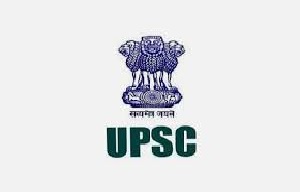UPSC Combined Geo-Scientist Main Exam Syllabus 2022
Organisation : Union Public Service Commission UPSC
Exam Name : UPSC Combined Geo-Scientist Main Exam 2022
Announcement : UPSC Combined Geo-Scientist Main Exam Syllabus
Website : https://upsc.gov.in/
What is UPSC Combined Geo-Scientist Main Exam?
Union Public Service Commission (UPSC) conducts a Combined Geo-Scientist and Geologist Examination (CGGE) for recruitment. Geoscientists study the physical aspects of the Earth, such as its composition, structure, and processes, to learn about its past, present, and future.

Syllabus For UPSC Combined Geo-Scientist Main Exam
The Syllabus For UPSC Combined Geo-Scientist Main Exam are given below,
Stage-II (Descriptive Type)
Section A : Physical geology & remote sensing
Evolution of Earth; Earth’s internal structure; earthquakes and volcanoes; principles of geodesy, isostasy; weathering- processes and products; geomorphic landforms formed by action of rivers, wind, glaciers, waves and groundwater; features of ocean floor; continental shelf, slope and rise; concepts of landscape evolution; major geomorphic features of India- coastal, peninsular and extra peninsular.
Electromagnetic spectrum; electromagnetic bands in remote sensing; spectral signatures of soil, rock, water and vegetation; thermal, near infra-red and microwave remote sensing; digital image processing; LANDSAT, IRS and SPOT- characteristics and use; aerial photos- types, scale, parallax, relief displacement; elements of image interpretation.
Section B: Structural geology
Principles of geological mapping; kinematic and dynamic analysis of deformation; stress-strain relationships for elastic, plastic and viscous materials; measurement of strain in deformed rocks; structural analysis of fold, cleavage, boudin, lineation, joint, and fault; stereographic projection of linear and planar structures; superposed deformation; deformation at microscale- dynamic and static recrystallisation, controls of strain rate and temperature on development of microfabrics; brittle and ductile shear zones; time relationship between crystallisation and deformation, calculation of paleostress.
Section C: Sedimentology
Classification of sedimentary rocks; sedimentary textures-grain size, roundness, spheri city, shape and fabric; quantitative grain size analysis; sediment transport and deposition- fluid and sediment gravity flows, laminar and turbulent flows, Reynold’s number, Froude number, grain entrainment, Hjulstrom diagram, bed load and suspension load transport; primary sedimentary structures; contemporaneous deformation structure; bio genic structures; principles and application of paleo current analysis; composition and significance of different types of sandstone, limestone, banded iron formation, mud stone, conglomerate;
Section D: Paleontology
Fossil record and geological time scale; modes of preservation of fossils and concept of taphonomy; body- and ichno-fossils, species concept, organic evolution, Ediacara Fauna; morphology and time range of Graptolites, Trilobites, Brachiopods, Lamellibranchs, Gastropods, Cephalopods, Echinoids and Corals; evolutionary trends in Trilobites, Lamellibranchs, Gastropods and Cephalopods; micropaleontology
Section E: Stratigraphy
Principles of stratigraphy-code of stratigraphic nomenclature of India; lithostratigraphy, biostratigraphy, chronostratigraphy and magnetostratigraphy; principles of stratigraphic correlation; characteristics of Archean granite-greenstone belts; Indian stratigraphy- geological evolution of Archean nucleii (Dharwar, Bastar, Singhbhum, Aravalli and Bundelkhand); Proterozoic mobile belts-Eastern Ghats Mobile Belt, Southern Granulite Terrain, Central Indian Tectonic Zone, Aravalli-Delhi Belt, North Singhbhum Mobile Belt.

Stage-II (Descriptive Type)
Geology : Paper-II
Section A : Mineralogy
Symmetry, motif, Miller indices; concept of unit cell and Bravais lattices; 32 crystal classes; types of bonding, Pauling’s rules and coordination polyhedra; crystal imperfections-defects, twinning and zoning; polymorphism, pseudomorphism, isomorphism and solid solution; physical properties of minerals; polarising microscope and accessory plate; optical properties of minerals- double refraction, polarisation, pleochroism, sign of elongation, interference figure and optic sign; structure, composition, physical and optical properties of major rock-forming minerals- olivine, garnet, aluminosilicates, pyroxene, amphibole, mica, feldspar, clay, silica and spinel group.
Section B : Geochemistry and isotope geology
Chemical composition and characteristics of atmosphere, lithosphere, hydrosphere; geochemical cycles; meteorites-types and composition; Goldschmidt’s classification of elements; fractionation of elements in minerals/rocks; Nernst’s partition coefficient (compatible and incompatible elements), Nernst-Berthelot partition coefficient and bulk partition coefficient; Fick’s laws of diffusion and activity composition relation (Roult’s and Henry’s law); application of trace elements in petrogenesis; principles of equilibrium and Rayleigh fractionation; REE patterns, Eh and pH diagrams and mineral stability.
Section D : Metamorphic petrology
Limits and physico-chemical controls (pressure, temperature, fluids and bulk rock composition) of metamorphism; concept of zones, facies, isograds and facies series, geothermal gradients and tectonics of orogenic belts; structures, micro-structures and textures of regional and contact metamorphic rocks; representation of metamorphic assemblages (ACF, AKF and AFM diagrams); equilibrium concept in thermodynamics; laws of thermodynamics, enthalpy, entropy, Gibb’s free energy, chemical potential, fugacity and activity.
Syllabus & Notification : http://www.syllabus.gen.in/uploads/pdf2022/2613-note.pdf
Section E : Geodynamics
Phase transitions and seismic discontinuities in the Earth; seismic waves and relation between Vp, Vs and density; seismic and petrological Moho; rheology of rocks and fluids (Newtonian and non-Newtonian liquids); rock magnetism and its origin; polarity reversals, polar wandering and supercontinent cycles; continental drift, sea floor spreading; gravity and magnetic anomalies of ocean floors and their significance; mantle plumes and their origin; plate tectonics- types of plate boundaries and their inter-relationship; heat flow and heat production of the crust.